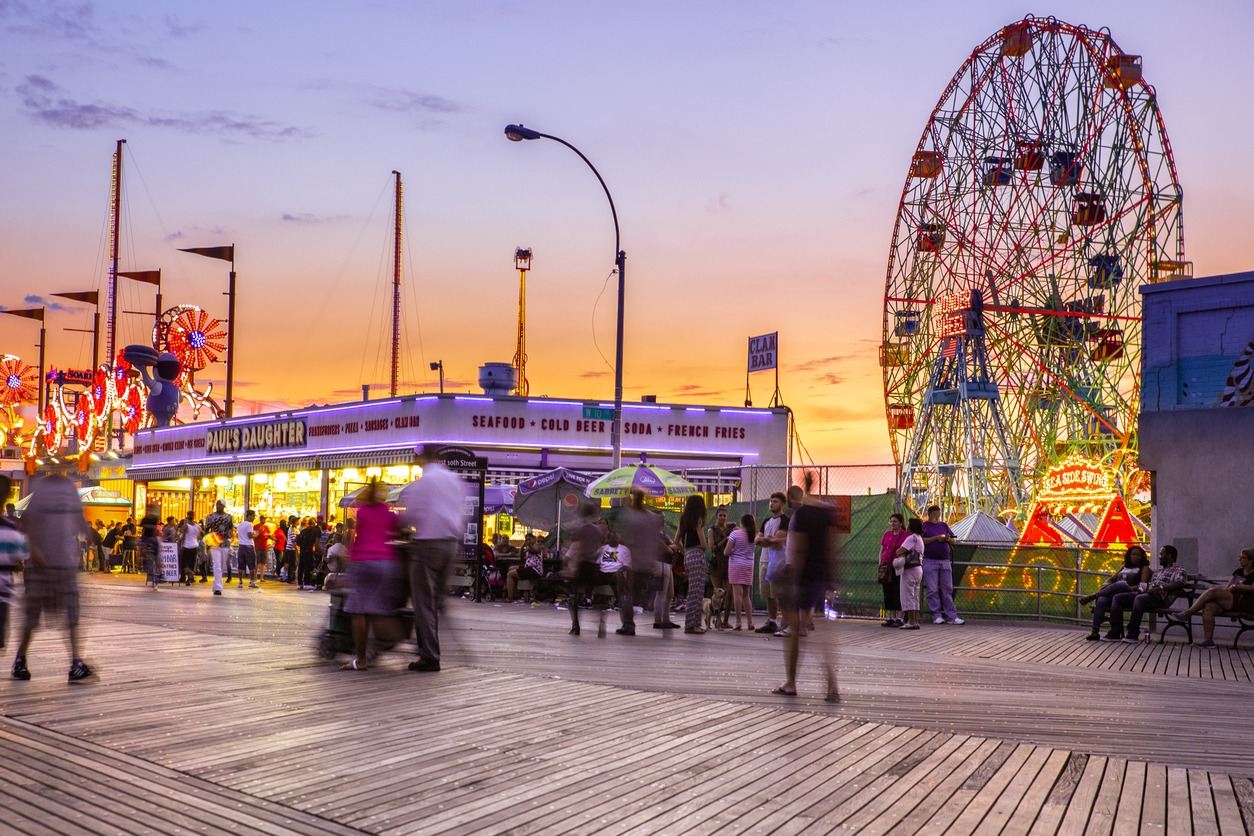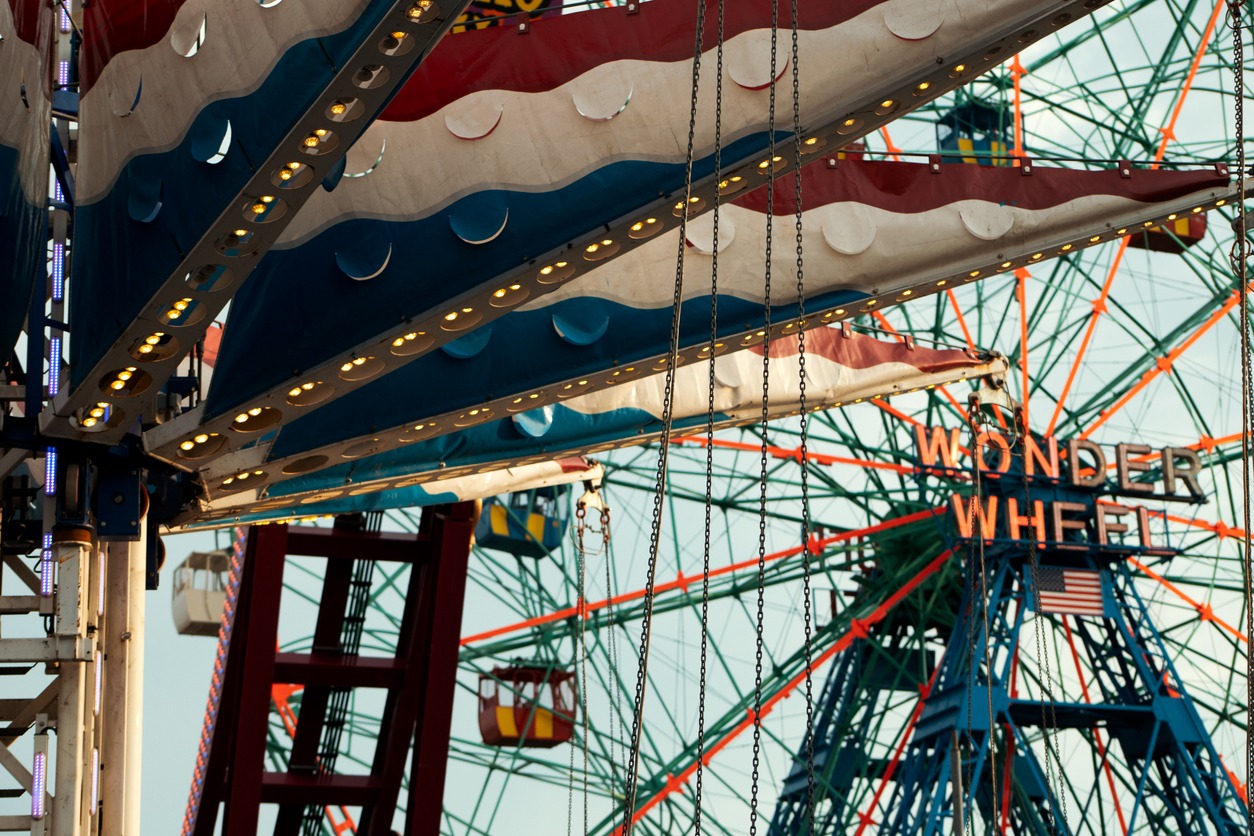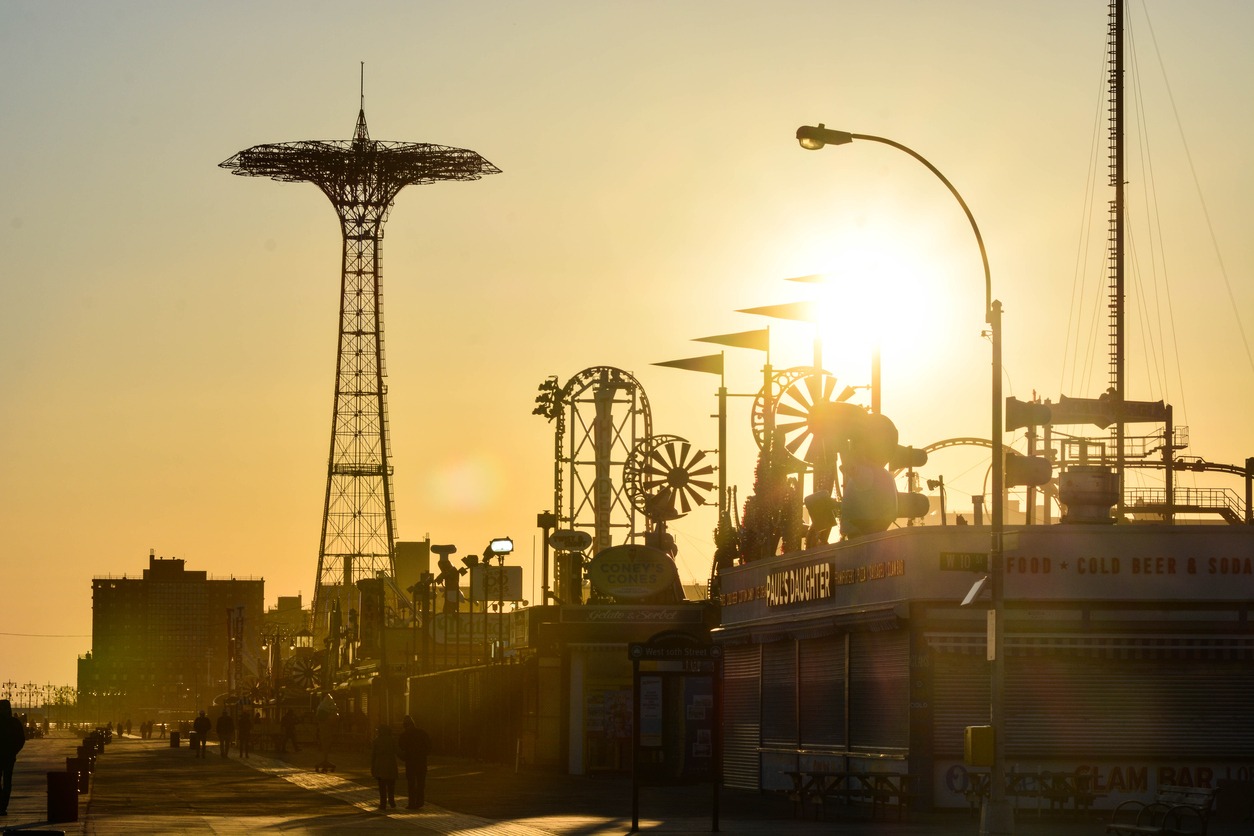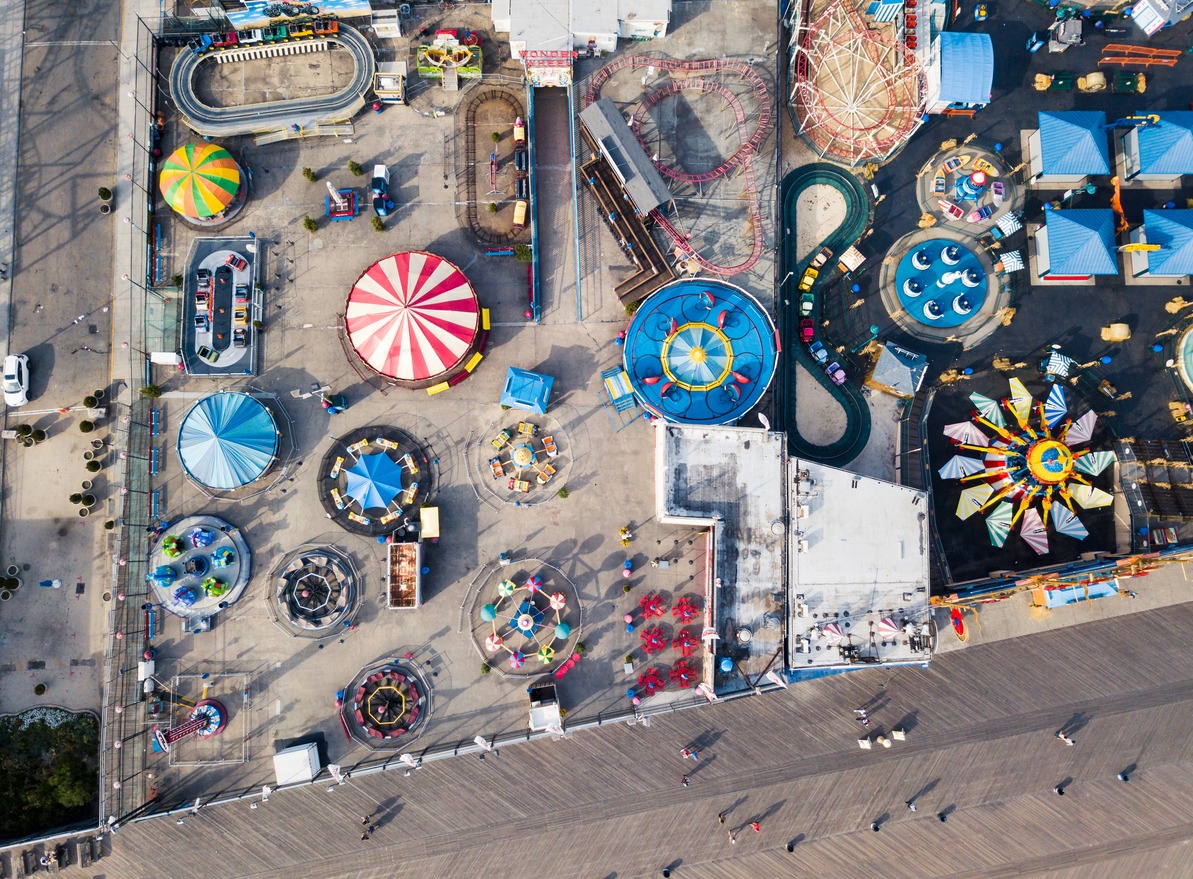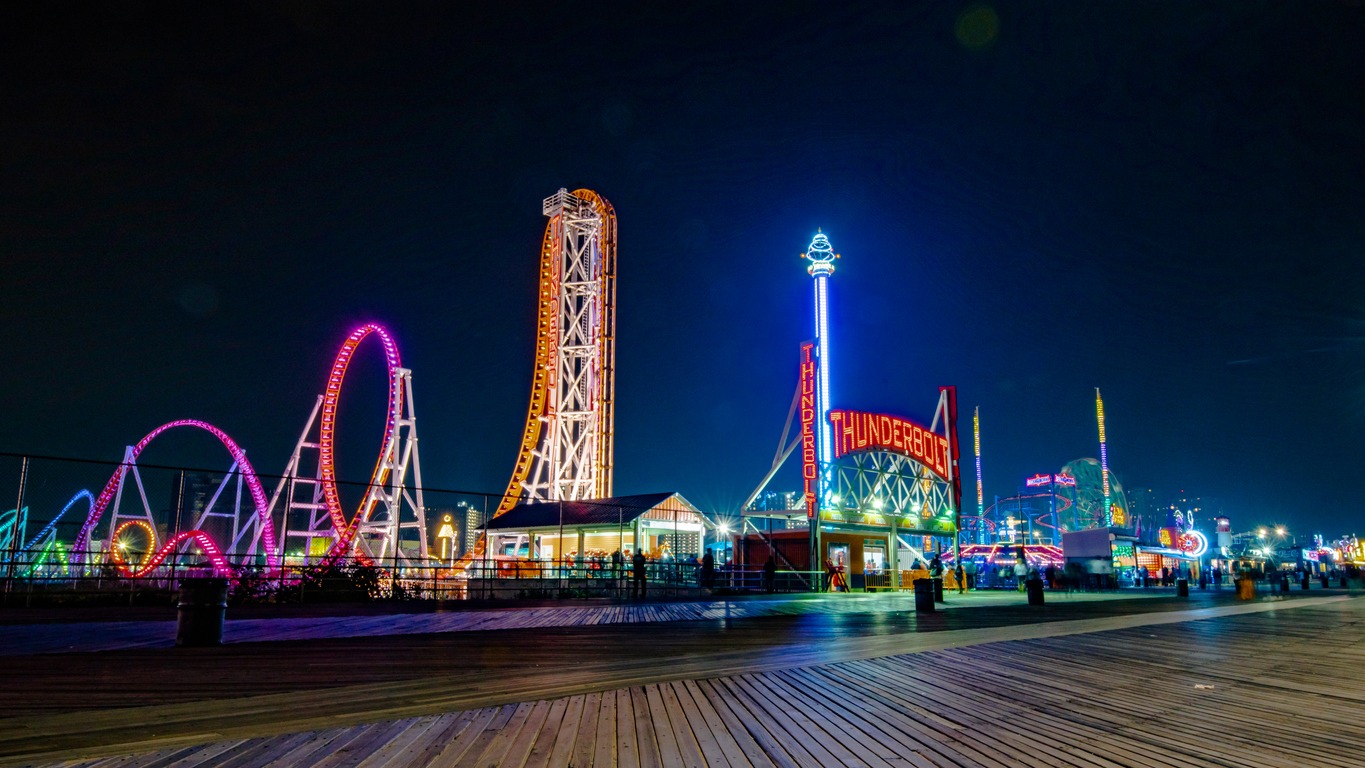Welcome to Coney Island, Brooklyn – a name that resonates with the sounds of laughter, the thrill of roller coasters, and the sweet scent of boardwalk treats. Located on the southern tip of Brooklyn, New York, Coney Island isn’t just a destination; it’s an experience steeped in history and American popular culture. From the rickety rides of yesteryear to the neon lights that dance across the night sky, Coney Island has been a beacon of joy and entertainment for generations.
In this blog, we embark on a nostalgic journey through the famed amusement parks of Coney Island—Luna Park, and Dreamland—exploring their rise, fall, and resurrection. We will stroll along the iconic boardwalk, a stretch of wooden planks that has witnessed a century of stories, and dive into the cultural significance of this legendary peninsula. Whether it’s the annual Mermaid Parade, the hot dog-eating contests, or the countless movies and songs that celebrate its spirit, Coney Island continues to hold a special place in the heart of American culture.
Join us as we uncover the enchanting history, enduring charm, and the endless wonder that Coney Island has to offer. It’s not just a trip to a historic amusement park—it is a ride through the heart of American joy and creativity.
Coney Island’s Transformation Through History
Coney Island’s history is a vibrant tapestry that reflects the evolution of American leisure and urban development. Situated in the southwestern part of Brooklyn, New York City, it is bounded by Brighton Beach, Gravesend, and the Lower New York Bay. Originally one of the Outer Barrier islands of Long Island, it transformed into a peninsula in the early 20th century through land reclamation. The name “Coney Island” carries a sense of mystery, with various theories about its origin, but it was initially part of the colonial town of Gravesend. As New York City grew in the 19th century, Coney Island began its transformation. By mid-century, it emerged as a seaside resort, drawing visitors to its shores for relaxation and entertainment. The development of transportation, including the introduction of railroads, made it increasingly accessible and popular.
The late 19th and early 20th centuries marked the heyday of Coney Island’s amusement era. It became famous for its innovative amusement parks, including Sea Lion Park, Steeplechase Park, Luna Park, and Dreamland. These parks were technological marvels of their time, featuring rides and attractions that captivated visitors from around the world. The Wonder Wheel, Parachute Jump, and the Cyclone roller coaster are just a few examples of the iconic structures that defined this era.
Throughout this period, Coney Island was more than just an amusement hub; it symbolized innovation and popular culture. It hosted grand events and spectacles, reflecting the optimism and inventiveness of the age. It was a place where the latest technological advancements and artistic expressions were showcased, from electric lights illuminating the night to extravagant firework displays.
In the 20th century, Coney Island continued to evolve, adapting to changing tastes and economic conditions. The introduction of new rides and attractions, along with efforts to preserve its historic landmarks, has marked its journey through the years. Today, Coney Island stands as a testament to the enduring appeal of seaside amusement and urban recreation. Its history is a story of transformation, reflecting broader trends in American society, from leisure and entertainment to urban development. As it moves forward, Coney Island continues to be a beloved destination, celebrating its unique heritage while looking toward the future.
In addition to exploring the Historical Seaside Splendor in Coney Island, learn more about Historical places in Brooklyn. Visit Discovering the Old Stone House in Brooklyn – A 1699 Dutch Farmhouse with Historic Significance.
The Island’s Historic Amusement Parks
From around 1880 until World War II, Coney Island stood as the preeminent amusement destination in the United States, drawing millions of visitors annually. Its emergence as a center for entertainment occurred alongside the rise of urban amusement parks across the country, revolutionizing leisure from a passive experience into something far more interactive and engaging. Here are the most notable ones:
1. Sea Lion Park (1895 – 1902): Sea Lion Park, marked a pivotal moment in the evolution of amusement parks. As one of Coney Island’s earliest enclosed amusement parks, it was modest in size but revolutionary in concept. Prior to its establishment, amusements were typically disparate and scattered, but Sea Lion Park introduced the idea of centralizing various attractions within a single, fixed location. This concept not only enhanced the visitor experience by offering a variety of amusements in one area but also laid the groundwork for the modern amusement park model.
At the heart of Sea Lion Park was its unique set of attractions, most notably the water chute ride, an early precursor to today’s log flumes and water coasters. This thrilling ride drew crowds eager for the novel experience of a splashy descent. Complementing the mechanical marvels were the park’s namesake sea lions. These live animal attractions captivated visitors with their playful antics and performances, adding a naturalistic charm to the park’s offerings. Though it operated for a relatively short period, Sea Lion Park’s influence was lasting. By pioneering the enclosed amusement park concept, it set a standard for future developments in the industry.
2. Steeplechase Park (1897 – 1964): Steeplechase Park stands out as one of Coney Island’s most enduring and beloved amusement venues. Established by George C. Tilyou, it is best known for its signature attraction, the mechanical horse race ride that gave the park its name. This ride, featuring mechanical horses racing along a track, offered visitors the thrill of a chase and the joy of friendly competition, encapsulating the lively spirit of the park itself.
The park wasn’t just famous for its innovative rides but also recognizable by its iconic Funny Face logo, a symbol that became synonymous with laughter and enjoyment. The Pavilion of Fun, another hallmark of Steeplechase Park, housed an array of amusements and diversions, further cementing the park’s reputation as a place of joy and entertainment. Steeplechase Park demonstrated remarkable resilience despite a devastating fire in 1907 that could have ended its story. It was rebuilt and expanded, emerging as a more comprehensive and diverse amusement park. This revival included an array of new rides and attractions, broadening its appeal and ensuring its status as a staple of New York leisure.
3. Luna Park (1903 – 1944): Luna Park embodied fantasy and innovation in the amusement world. Created by visionaries Frederic Thompson and Elmer “Skip” Dundy, the park was celebrated for its stunning architecture and the brilliant glow of thousands of electric lights, a spectacle of technology and design that symbolized the excitement of the new century. The park’s architecture was more than just buildings; it was a dreamscape, featuring exotic towers, domes, and minarets that seemed to transport visitors to another world. At night, Luna Park became a fairyland of lights, dazzling visitors with its luminescent allure and becoming a beacon of wonder visible from miles around.
Among the various rides and attractions, the “Trip to the Moon” was a standout, offering a fantastical voyage that captured the public’s imagination. This ride exemplified the park’s ability to blend storytelling, technology, and entertainment, providing a thrilling and whimsical experience. Moreover, Luna Park’s grandeur and fantasy-like experience were unparalleled, making it a jewel of Coney Island during its first heyday of amusement parks. It drew crowds from all walks of life, eager to experience the magic and marvel that the park promised.
4. Dreamland (1904 – 1911): Dreamland might have had the briefest existence among Coney Island’s pantheon of amusement parks, but its impact and grandeur were unmatched. It was the epitome of opulence and extravagance in the early 20th-century amusement park scene, outshining its contemporaries with larger, more ornate structures and a diverse array of attractions.
The park’s design was a feast for the eyes, featuring majestic towers and buildings that exuded an air of elegance and fantasy. Dreamland was not just about the visual spectacle; it provided a variety of experiences that appealed to all senses. Among its many attractions, the railway that meandered through a recreated Swiss alpine landscape and a miniature railroad captivated visitors with their detailed and immersive environments. These attractions were not just rides; they were adventures that transported visitors to far-off places and imaginative worlds. Despite its wonders, Dreamland’s tenure was tragically cut short. In 1911, a catastrophic fire engulfed the park, leading to its complete destruction. The fire ended Dreamland’s operation and marked the end of an era of extravagant amusement parks.
These parks helped establish Coney Island’s reputation as a wonderland of amusement and influenced the development of amusement parks worldwide. Each park had its own character and set of attractions, but all shared the common goal of providing unprecedented forms of entertainment and escape. Their legacies live on in the collective memory of Coney Island and continue to inspire the amusement industry today.
The Decline of Coney Island’s Amusement Parks
The demise of Coney Island’s famed amusement parks was a gradual process, influenced by an array of societal and economic changes. The Great Depression marked the beginning of a downward spiral, severely impacting attendance and revenue as people grappled with financial hardship. As the 20th century progressed, evolving social norms and new forms of entertainment, such as television and suburban leisure opportunities, began to compete with the allure of the amusement parks. The advent of cleaner, more family-oriented theme parks further diverted the public’s interest away from Coney Island’s offerings.
The urban decline also took its toll on the area, with rising crime rates and deteriorating infrastructure deterring future visitors. This period of decline was exacerbated by the encroaching pressure of real estate development, as the valuable land of the amusement parks became increasingly eyed for residential and commercial projects. Furthermore, the parks, many constructed with wooden structures, were vulnerable to fires and natural disasters, leading to costly damages and a tarnished image.
Moreover, neglect and mismanagement also contributed to the parks’ downfall, as dwindling investments failed to keep up with maintenance and innovation demands. Despite these myriad challenges leading to their closure, the legend of Coney Island’s amusement era lives on, remembered for its once-gleaming attractions and its significant place in the history of American leisure and entertainment.
Coney Island’s Famous Boardwalk
Coney Island’s boardwalk, officially known as the Riegelmann Boardwalk, is one of the most iconic symbols of Brooklyn’s storied seaside resort. Stretching approximately 2.7 miles along the sandy shores of the Atlantic Ocean, it’s been a fixture of the area since it was opened in 1923, named after Edward J. Riegelmann, a former Brooklyn Borough President.
The boardwalk has been the backdrop for countless strolls, games, romantic walks, and community gatherings, absorbing the history and culture of Coney Island into its planks. It’s a place where the past and present merge, with the laughter and music of decades echoing through its length. Along the boardwalk, visitors can find a variety of attractions, from the remnants of old amusement parks to modern eateries, arcades, and shops.
Over the years, the boardwalk has seen everything from high-stepping musical performances to quiet, reflective moments by the sea. It’s home to the famous Nathan’s Hot Dog Eating Contest, an annual July 4th tradition that draws competitors and spectators from around the world. The boardwalk also provides front-row seats to the Mermaid Parade, a unique celebration of art, culture, and the beginning of the summer season.
Despite weathering storms and changes, the boardwalk has undergone several renovations to preserve its structure and the nostalgic feel, making it an indispensable part of the Coney Island experience. It’s more than just a pathway by the beach; it’s a living piece of New York’s history, a communal space that has brought together generations of visitors and locals alike. The Coney Island boardwalk continues to be a beloved destination, inviting everyone to walk, relax, and indulge in the timeless charm of seaside leisure.
The Enduring Influence of Coney Island on American Culture
The amusement parks and boardwalk of Coney Island have woven themselves into the fabric of American culture, epitomizing the nation’s evolution of leisure and entertainment. These iconic spaces heralded a new era of innovation and enjoyment, reflecting the burgeoning spirit of escapism and delight in the industrial age. They were the playgrounds where technological marvels met the public’s growing appetite for excitement, introducing the world to the wonders of roller coasters, Ferris wheels, and electric lights. As such, they were not just places of amusement but beacons of progress, showcasing the latest in engineering and design.
Beyond their technological feats, Coney Island’s amusements democratized leisure, creating a space where individuals from all walks of life could mingle and revel in the joys of life. The boardwalk, in particular, became a symbol of community and inclusivity, a stretch of wood along the ocean where the worries of the city dissolved into the laughter and music of a shared experience. This aspect of Coney Island profoundly influenced American culture, promoting a sense of unity and collective identity.
Moreover, the imagery and lore of Coney Island have permeated American arts and narratives, becoming a staple in literature, cinema, and art. It is a place of nostalgia, often invoked as a symbol of a golden era of innocence and excitement. The rise, decline, and revival of these amusement spaces parallel the broader story of America’s trials and transformations, reflecting the nation’s resilience and enduring quest for joy and community.
In every light bulb that illuminated the night, every scream of thrill from the roller coaster, and every quiet moment of contemplation on the boardwalk, Coney Island has contributed to the American ethos, capturing the imagination and hearts of generations. Its legacy is a testament to the importance of leisure and communal space in American life, reminding us of the value of wonder and togetherness in the ever-evolving narrative of the nation.
Pop Culture References to Brooklyn’s Coney Island
Coney Island in Brooklyn, New York, is a significant cultural landmark, often featured in various forms of media. Here are some pop culture references to Coney Island:
Movies:
- The Warriors (1979): A cult classic film where a New York City gang must return to their home turf in Coney Island while other gangs pursue them.
- Requiem for a Dream (2000): A film that depicts the lives of four individuals dealing with addiction, with several key scenes set in Coney Island.
Music:
- “Coney Island” by Taylor Swift (featuring The National): A song from her album “Evermore” that references the nostalgic and bittersweet feelings associated with Coney Island.
- “Coney Island Baby” by Lou Reed: A song expressing Reed’s fondness for the area, reflecting on his personal experiences.
Literature:
- Last Exit to Brooklyn by Hubert Selby Jr.: A novel that offers a raw, gritty portrayal of life in Brooklyn, including Coney Island, in the 1950s.
- Coney Island of the Mind by Lawrence Ferlinghetti: A collection of poems that metaphorically references Coney Island to explore various themes.
Television:
- Mr. Robot: The show features several critical scenes set in Coney Island, which serves as a significant location throughout the series.
- Boardwalk Empire: While primarily set in Atlantic City, it includes references and comparative elements to Coney Island’s historic amusement area.
Video Games:
- The Warriors (video game): Based on the 1979 movie, it includes Coney Island as a significant setting within the game.
- Grand Theft Auto IV: Features a fictional amusement park called “Firefly Island,” inspired by Coney Island.
Art and Photography:
- Coney Island has been the subject of numerous works by photographers and artists, notably through capturing its vibrant amusement parks, beaches, and community.
Historical References:
- Coney Island is often mentioned in documentaries and historical accounts, especially focusing on its heyday as an amusement and leisure destination in the early 20th century.
These references encapsulate Coney Island’s cultural, historical, and emotional significance in American popular culture. Whether it’s through the nostalgic lens of music, the gritty realism of movies and literature, or the virtual depiction in video games, Coney Island continues to inspire and intrigue.
Conclusion
Coney Island’s amusement parks and boardwalk have left an indelible mark on American culture, encapsulating the spirit of innovation, community, and joy. These historical spaces have revolutionized entertainment with technological marvels and fostered a sense of unity and democratic leisure. As symbols of nostalgia, progress, and resilience, they reflect the evolving narrative of America itself. Moreover, the story of Coney Island is a testament to the enduring human desire for amusement and connection, reminding us of the shared experiences that define our cultural heritage. As we look back on the glittering lights and joyous sounds of Coney Island, we recognize its profound role in shaping the cultural landscape of the nation.

